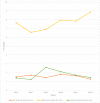The Burden of HIV, Hepatitis B and Hepatitis C by Armed Conflict Setting: The Nigeria AIDS Indicator and Impact Survey, 2018
- PMID: 34221906
- PMCID: PMC8231456
- DOI: 10.5334/aogh.3226
The Burden of HIV, Hepatitis B and Hepatitis C by Armed Conflict Setting: The Nigeria AIDS Indicator and Impact Survey, 2018
Abstract
Background: Against a background of security challenges, Nigeria conducted recently the largest population-based HIV survey in the world to ascertain the burden of the HIV disease in the country.
Objective: We evaluated the main outcomes of the survey and the level of success using participation/response indicators.
Methods: The survey was conducted from July-December 2018 by over 6,000 field staff across Nigeria in six consecutive webs, using two-stage cluster sampling. We estimated the prevalence of HIV, hepatitis B and hepatitis C in the entire country and by conflict zone status. Adjusted odds ratios (OR) and 95% confidence intervals (CI) from survey logistic regression models were used to compare the likelihood of test positivity for the three infections between zones.
Findings: A total of 186,405 adults were interviewed from 97,250 households in 3,848 census enumeration areas. The overall HIV, hepatitis B and hepatitis C positivity rates were 1.55%, 7.63% and 1.73%, respectively. The prevalence of HIV, hepatitis B and C infection was significantly greater in conflict than non-conflict zones (HIV: 1.75% versus 1.0%; hepatitis B: 9.9% versus 7.3%; and hepatitis C: 3.2% versus 0.3%; p < 0.01 in all cases). Individuals living in conflict zones were about three times as likely to test positive for HIV (OR = 2.80, 95% CI = 2.08, 3.60) and nearly six times as likely to test positive for hepatitis C (OR = 5.90, 95% CI = 2.17, 16.67).
Conclusion: Large population-based surveys are feasible, even in armed conflict settings. The burden of HIV, hepatitis B and hepatitis C was significantly higher in areas of conflict in Nigeria, highlighting the need for reinforced public health control measures in these settings in order to attain UNAIDS' 95-95-95 targets of controlling the HIV epidemic in sub-Saharan Africa by 2030.
Copyright: © 2021 The Author(s).
Conflict of interest statement
The authors have no competing interests to declare.
Figures
References
-
- ICAP at Columbia University. PHIA Project – A drop that counts: About. 2019. https://phia.icap.columbia.edu/about/. Accessed September 8, 2019.
-
- Centers of Disease Control – Global Health. Nigeria Studies Cameroon’s PHIA Implementation. 2018. https://www.cdc.gov/globalhealth/stories/nigeria_studies_cameroon_implem.... Accessed September 8, 2019.
-
- Goodhand J. Research in conflict zones: Ethics and accountability. Forced Migr Rev. 2000; 8(4): 12–16.
-
- Romano D. Conducting research in the Middle East’s conflict zones. Political Science and Politics. 2006; 39(3): 439–441. DOI: 10.1017/S1049096506060768 - DOI
-
- Gasser N. Conducting field research in contexts of violent conflict. An annotated bibliography. NCCR North-South Dialogue, WP 1 “Governance and Conflict” Working Paper No. 3, 1–40. Bern: NCCR North-South; 2006.
Publication types
MeSH terms
Grants and funding
LinkOut - more resources
Full Text Sources
Medical



